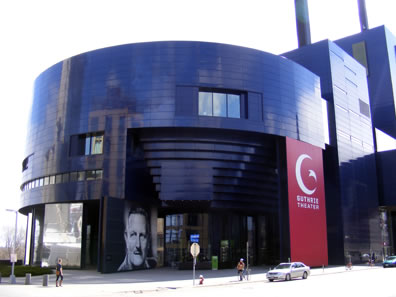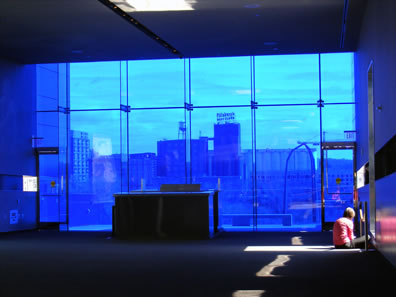Crimes of the Heart
Bringing the Southland to a Midlands Treasure
By Beth Henley
Guthrie Theater, Wurtele Thrust Stage, Minneapolis, Minn.
Saturday, May 3, 2014, Aisle 3, Row K, Seats 305&306 (middle left)
Directed by Marcela Lorca
One night, we are watching William Shakespeare's Hamlet being performed on the Guthrie Theater's McGuire Proscenium Stage. The next night we are watching Beth Henley's Crimes of the Heart on the Guthrie's Wurtele Thrust Stage. The link between these two events is, of course, Elsinore.
OK, sometimes I use the phrase "of course" too often. It's my "like" and "you know" and "the fact of the matter is," a rhetoric non-necessity that I drop into expressions more out of habit than purpose. Any reader who has seen Crimes of the Heart is probably wondering where Elsinore pops up in that play. It doesn't (its setting is Hazlehurst, Mississippi, in 1964), but this is less a review of the production (for reasons of journalistic integrity) and more about a gem of a theater complex, the Guthrie, sitting on the banks of the Mississippi River in downtown Minneapolis, Minnesota.

The Guthrie Theater, above, and inside the Endless Bridge where the general public can hang out any time the building is open. Photos by Eric Minton.

Elsinore is the legendary royal castle of Denmark where Hamlet is set. In 1937, the real Elsinore Castle hosted the legendary Old Vic production of Hamlet starring Laurence Olivier as the Prince of Denmark with Alec Guinness as Osric. The production was helmed by one of England's most visionary directors at the time, Tyrone Guthrie. In his book Blessings in Disguise (1985, Hamish Hamilton), Guinness describes the production's first night performance before Danish nobility, which, because of a terrible storm, was moved from the castle courtyard to the ballroom of the Marienlist Hotel. Unable to use their stage in the castle courtyard, Guthrie marked out a circle in the middle of the ballroom to serve as the play space, and he arranged the theater seating to allow various avenues of access to the stage through the audience. Guthrie gave rudimentary instructions, including suggesting that Osric enter through a set of French windows opening onto the beach, which, Guinness pointed out to the director, was being lashed by roaring wind and rain. "Arrive wet. Very dramatic," Guthrie replied. The bulk of the action during the actual performance was improvised. "It was the most exciting theatrical experience most of us had ever had," Guinness writes.
He also credits this moment for Guthrie's creation of the modern thrust stage, the prototype for a kind of theater the director would build later to serve as the centerpiece to the two famous theaters he founded, the Stratford Festival in Canada and the Guthrie Theater in Minneapolis, which opened in 1963 with a production of Hamlet. Unlike the form used in Shakespeare's time, in which a square platform jutted out into the audience with the actors playing above the groundlings, Guthrie's thrust stage is semicircular with angles, as in a pentagram, and sections of grandstands fanning out from stage level and up with "voms" between seating sections through which the actors can reach the stage. This arrangement of stage and audience allows for intimacy even in a theater seating more than a thousand while still providing a proscenium arch at the back of the stage against which even elaborate sets can be built. For Crimes of the Heart, Designer James Youmans has built a complete kitchen with a living room stairway going up to one side, the Southern home's yard visible through the door and windows, and Hazlehurst's water tank tower in the distance.
This blend of classic and modern theaters has been emulated in other structures since the Guthrie's opening, including what was first called the Mummer's Theater in Oklahoma City but was known as the Oklahoma Theatre Center when I worked there in 1983 (it is now the shuttered Stage Center). As public relations director at the Oklahoma Theatre Center, one of my duties was to give tours of the building, so I knew of the Guthrie Theater's legacy and had always longed to visit it. I finally got the chance last weekend, though the original Guthrie is no more. In 2006, the theater opened a new structure at a new site right on the banks of the river.
Along with replicating the former's famous thrust theater (with more leg room for the audience and more modern amenities), the new complex by French architect Jean Nouvel is as dramatically engaging as any play it might produce or host. Even its color is dramatic: a deep blue that Nouvel called l'heure entre chien et loup, the hour between the dog and the wolf, or twilight. The structure is a combination of circular tower and large block that mirrors the old flour mills in its neighborhood, plus a cantilevered hallway (called the Endless Bridge) that sticks out 178 feet toward the river. This bridge, which serves as a ramp between levels, does have an end: a porch with the best view of the historic Stone Arch Bridge crossing the Mississippi just below the St. Anthony Falls.
The Guthrie now has three theaters: the 1,100-seat thrust stage; the lush, overly red proscenium stage seating 700; and a black box theater called the Dowling Studio named after current (and soon-to-retire) Artistic Director Joe Dowling. The Guthrie also houses meeting spaces, a scene shop that had my wife, the retired Air Force aircraft maintenance commander, salivating over its size and capabilities, and the restaurant Sea Change, which I give a 5-star rating in menu, preparation, presentation, and service. One of the coolest things the Guthrie does is open its lobbies to the general public any time the building is open. You don't have to be there to see a play or take a tour or attend a class or work; you can hang out in the lounge or write in your journal next to one of the large picture-view windows on the Endless Bridge.
But all readers of Shakespeareances.com should endeavor to see a play there, too—and not just Shakespeare. Dowling has ensured a varied menu of theatrical choices throughout the year (check out Shakespeareances.com's Bard on the Boards listing) by putting together a subscription series of Guthrie productions that include classics and modern works, popular musicals and experimental pieces; by providing space to local theater companies to stage their productions at the Guthrie; and by hosting touring companies, such as The Acting Company that staged the Hamlet and Tom Stoppard's Rosencrantz and Guildenstern Are Dead that I reviewed earlier this week. Those two plays were in the proscenium theater, and because I most wanted to see a production on the thrust stage, we timed the Guthrie portion of our visit to Minneapolis so that we could see Crimes of the Heart on its first preview night. It would not be kosher for me to offer up a review of a production based on a first-night preview performance, so I'll limit my observations to the play itself.
Henley's Pulitzer Prize–winning play, originally produced in Louisville in 1979 and then in New York the next year, fits in the genre of "Southern Gothic." Like all Gothic fiction, it exaggerates the psychopathic qualities of individuals and a community, though this flight of fantasy is grounded in some degree of truth. It centers on the three Magrath sisters, now adults, the products of a father who abandoned the family and a mother who hung herself, after which the three girls were taken in by their grandfather, who is now in the hospital after a stroke. A strand of mental illness obviously runs through this family, so for three actresses in this six-actor play, the broadstroke-drawn Magrath sisters provide outsized characters and several absurdist lines to chew on.
Lenny, the eldest sister (Maggie Chestovich), has been grandfather's caretaker that, along with her infatuation with a female-oriented impairment, seems to have stunted her emotional desires. The youngest sister, Babe (Ashley Rose Montondo), has just shot her husband, Zackery, a prominent politician in the community. The whole play takes place in the 24 hours after Babe has been released on bail (and it also happens to be Lenny's birthday). The question of Babe's intent in shooting her husband is established shortly after we first meet her. "I shot him, all right," she explains to her sisters. "I meant to kill him. I was aiming for his heart, but I guess my hands were shaking and I just got him in the stomach." And after she shot him, she made herself a pitcher of lemonade and then offered some to Zackery. "He was looking up at me trying to speak words. I said, 'What? Lemonade? You don't want it? Would you like a Coke instead?'" Young lawyer Barnette Lloyd (David Darrow) has taken on Babe's case in order to engage in a not-fully-explained vendetta against Zackery.

The Magrath sisters share a memory in Lenny's kitchen in the Guthrie Theater production of Beth Henley's Crimes of the Heart on the theater's Wurtele Thrust Stage. From left is Lenny (Maggie Chestovich), Babe (Ashley Rose Montondo), and Meg (Georgia Cohen). Photo by Joan Marcus, Guthrie Theater.
Middle sister Meg (Georgia Cohen) had moved to Hollywood to pursue a singing career and left behind a reputation as the Hazlehurst slut. As her show business career fizzled she suffered a nervous breakdown. She's back home to support Babe and perhaps resume her lust-chasing ways with old flame Doc Porter (Sam Bardwell), now married to a Yankee with two "half-Yankee" children. The two were enjoying a tryst in Biloxi when Hurricane Camille hit, and Meg convinced him to ride out the storm; he was injured, and she abandoned him. I worked for the newspaper in Biloxi more than 20 years after Camille hit, but the killer storm's omnipresent legacy in that community—including the notorious "hurricane party" in a beach-side apartment complex that ended up being swept away by the record surge, killing everybody inside—has stayed with me, so I feel the aptness of Henley's historical reference and metaphor.
Yet, Henley's keenest creation is the Magraths' cousin, Chick (Sarah Agnew), a Hazlehurst socialite navigating the tightrope between her blood ties and her social-climbing ambition. Being a Southerner by blood and having lived about half of my life as an Air Force dependent in Dixie, Chick's is the South I'm most familiar with. She makes a huge first impression on the audience when she changes panty hose without removing her dress. First, there's the fact that she had asked Lenny to get her "extra petite" when it's obvious this tall woman is a size medium at least, and then she complains that manufacturers are skimping on the nylon. In her stage directions, Henley wants the action to be "something slightly grotesque about this woman changing her stockings in the kitchen," but it's clear to me in Agnew's performance that this Chick is expert at changing panty hose in restaurant restrooms before Ladies' League luncheons or in classroom closets before PTA meetings. This and other clues—her birthday gift to Lenny is chocolates in a box adorned with pictures of poinsettias (obviously left over from last Christmas), and she openly flirts with Doc and yet condemns Meg for the attention she gives the married man—says more about Chick than the lines she actually speaks.
That's the art of good theater: transporting you to a psychological and emotional place and time and condition that are something other than your actual physical state of existence. It can happen on bare stages, on living stages, and on one of the world's most singular, historical stages.
Eric Minton
May 8, 2014
Comment: e-mail editorial@shakespeareances.com
Start a discussion in the Bardroom



 Find additional Shakespeareances
Find additional Shakespeareances